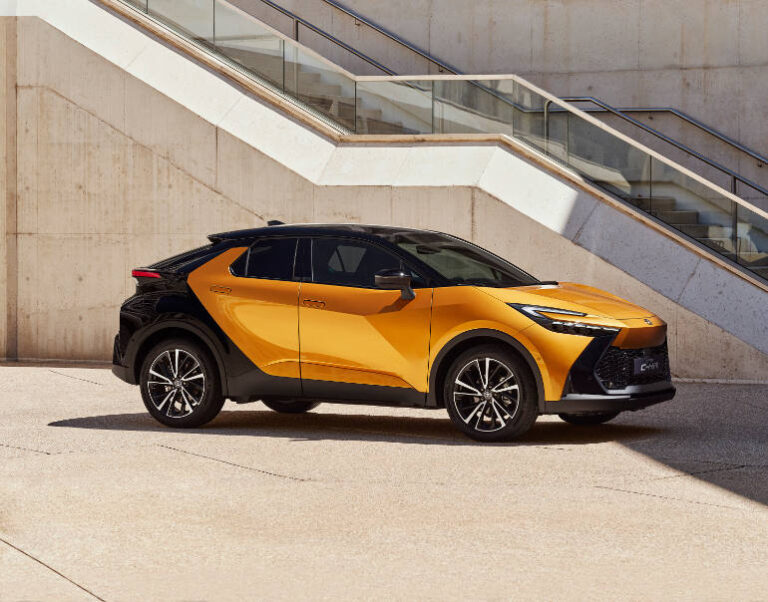If a stylish, small, hybrid SUV is something that appeals to you, the Toyota C-HR could be a terrific fit for your needs…. If you can justify the cost.
The pricing for the new-generation model has seen a big jump over its predecessor. The three-model line-up starts at $42,990 plus on-roads for the base model GXL 2WD, while the Koba 2WD is $49,990 plus on-roads, and the range-topping GR Sport is $54,990 plus on-roads.
If you’re outlaying that kind of cash from your bank account, it might seem painful. But for those who plan to lease this car, it could make a lot of sense.
Toyota Australia says there will be plenty of private customers who run a C-HR on a novated lease, to take advantage of the pre-tax benefits on offer for this car which, otherwise, should be very affordable to own and run.
That’s partly due to the fact it has a choice of two frugal powertrains. The first is a 1.8-litre petrol-electric hybrid (combined output 103kW) with CVT auto and front-wheel drive in the GXL and Koba, with an official combined cycle fuel consumption figure of 4.0 litres per 100km, making it one of the most efficient plugless models on the market. The GR Sport, which has a more powerful 2.0-litre hybrid (146kW) with all-wheel drive, still manages to sip just 4.1 litres per 100km on the combined cycle.
Both versions drive well, with the latter clearly offering a bit more fun factor in terms of acceleration, and it also has bigger brakes for better stopping power. The GXL is the pick for those who prefer a cushy ride, but all of them have decent handling and steering, and pretty good levels of refinement for the class, too.
At the launch event of the C-HR, I saw a return of 4.7L/100km in the entry version, and 5.5L/100km in the flagship. While that’s a bit higher than the claim, it’s still very efficient.
It’s also worth noting the service costs – $200 per service for the first five years/75,000km – are better than pretty much anything else out there, and indeed, less than half of what Kia and Hyundai ask for their hybrid models. But those brands have other perks like roadside assistance included at no cost – you have to pay extra at Toyota.
All of that may factor into your decision-making process, and so should the fact the C-HR is a compelling choice for those who want a small SUV that’s more focused on style than practicality.
The swooping roofline leads to a tailgate without a rear wiper (boo!), but there’s no denying this car has plenty of presence, thanks to its standard LED exterior lighting across the range, and the brand’s new ‘Hammerhead’ styling language. It’s also the first Toyota with flush-fit door handles, and the rear handles are now in a more sensible position, too.
Inside, the C-HR looks very driver-focused, with a cockpit design that clearly delineates the driver’s zone and the passenger’s. It is still a cramped feeling place like the first-gen, but with much more tech and wow factor by way of a larger 12.3-inch touchscreen media system, and digital instrumentation for the driver (7.0-inch for the GXL, 12.3-inch for the higher grades).
You can really see and feel the difference if you spend up to the Koba, with more succulent finishes and even 64-colour ambient lighting for that spec and the GR Sport. Both of them have some materials made from recycled bottles and, fun fact, the C-HR contains no animal derived products whatsoever.
For those who plan to use the back seat regularly, there’s a good amount of space, but the space itself isn’t very nice. The windowline is very high and the headliner is black, meaning parents with kids might find it a very unfriendly spot for carsick-prone travellers. There are also no directional air-vents, no fold-down armrest with cupholders, and you only get a single map pocket and USB charger in the higher grades. Beyond that, the rear-seat door cards are a single piece of scratchy plastic – including the elbow pads. Very unpleasant.
Boot space for the GXL and Koba versions is 388 litres, which is decent for such a small SUV (it measures just 4360mm long), while the AWD GR Sport has 362L of cargo capacity due to extra hardware under the floor. There’s a space-saver spare tyre in the GXL, but the others have a tyre repair kit. All grades have tyre pressure monitoring.
Helping offset the huge price rise is a massive safety tech inclusion list.
All C-HR models have autonomous emergency braking with pedestrian, cyclist, junction and head-on detection, radar-based adaptive cruise control, lane keeping assistance and a driver monitoring camera. It’s not easy to see out of this car, so it’s good to see there are front and rear parking sensors with low-speed auto braking, and there’s a surround-view camera for parking moves, plus blind-spot monitoring and rear cross-traffic alert. Plus the top grades get a digital camera mirror, too, and the C-HR also scores 10 airbags.
The new C-HR is built in Turkey, and is only sold in Europe and Australia – which is partly why it costs so much more than the first-gen model.
In some ways, it seems like a decent value offering if you put styling ahead of substance – but it’s hard to recommend it for a pragmatic buyer, when the Corolla Cross SUV is cheaper, more spacious and arguably easier to live with.






